Genre: Platformer Developer: Micro World Publisher: Renovation Players: 1-2 Released: 1991
Believe it or not, there was a time when multi-player games weren’t as commonplace as they are now. This changed in the palindrome year with the 1991 release of two landmark games: Faceball 2000 for the Nintendo GameBoy and Todd’s Adventures In Slime World for the Atari Lynx. Though it would be quickly bettered by Faceball 2000’s 16-player capability, Slime World was the first game which allowed eight players to play at once, an incredible experience, albeit still not as impressive as actually knowing eight individual Lynx owners assembled in the same room to enjoy the game together.
Players take control of the eponymous Todd, armed with a water gun, on one of six different missions deep into a slime planet. Each mission mode has its own rules to change the way the game plays — the Suspense mode has a timer that will blow up the planet unless you find time-restoring mushrooms, and Logic one gets rid of your water gun, forcing you to rely on items to survive to the end. Of course, the original main selling point was its ComLynx mode, which allowed up to seven other players to join in, exploring the caverns together or competing to be the last one alive.
So how does the Genesis port handle eight players, each with his own view of the action and menu? For once, Genesis doesn’t. Due to the obvious limitations of being confined to a single television screen, the Genesis port of Slime World is strictly a two-player horizontally split-screen affair. While the game includes faithful renditions of all of the various modes of play, being limited to just one other person really hurts a game known for its multi-player gameplay. Slime World is largely designed as such, and to strip that from the title diminishes its appeal.
Looking past that shortcoming, the game still plays as well as it did on the Lynx, though Todd remains clunky to control in both versions. His jumps are awkward and floaty, movements are slow and stiff, and general navigating seem “off” by platform game standards. He can climb up most any wall he encounters, and he’ll start crawling the moment he touches it. Todd can shoot his water gun every which way, but his aim doesn’t smoothly transition from one point to the next. Aiming is a tap-tap game of getting the right angle for the shot you want to make, but that’s okay, as Slime World isn’t a fast action game. You’ll want to take your time, since recklessness will kill you.
Slime World is littered with monsters and slime (obviously). The ceiling drips slime. You’ll leap across slime pits and encounter slime waterfalls. Contact with enemies will hurt you and attacking one will explode it into “boogers.” When any slime from the above contacts Todd, it’ll leach onto him and gradually turn him green. Greater exposure will expedite the process, and when Todd is completely green, he’ll pop and die. He’ll also die upon contact with red slime – it has a fatal touch, but lucky for Todd, he won’t encounter it much during the game.
Todd can take comfort in knowing that the green slime can be washed off. Throughout the game you’ll come across water pits, and there Todd will scrub off the slime until he’s good as new. Items will also help you survive, and you’ll pick up slime shields (invincibility), slime bait (food that attracts and kills enemies), cleanser (turns slime pits into water pits), jet packs for flying, gun power-ups for a triple water shot, and mega bombs that will destroy everything in the room it’s thrown into, including Todd if he’s not quick to exit. Slime World is also littered with slime gems, and they are good points but also clean Todd off a bit (red slime gems clean Todd completely and grant a slime shield).
Slime World is a large maze, and every inch of it appears in this Genesis port. One of the nice things about this version is the increased screen size allows both for a greater view of Todd’s surroundings but also a view of the map. This makes the Genesis game easier than the Lynx original, where you had to assume danger was always just a few feet away. Being on a TV also allows for enough space to have the map be a permanent fixture on the screen, instead of being accessed as a submenu option as with the Lynx game. The ever-present map makes it impossible to really lose your sense of place, and it soils the multi-player mode – well, the competitive two-player mode at least – and lessens the whole exploration aspect somewhat. Also, as with the original, once you beat the game, the thrill of venturing out into the unknown is gone a la Metroid. A random level generator would be a welcomed addition, but that would appear to be asking too much of this Genesis conversion.
Still, what really bothers me about Slime World is how shoddy a port it is. The Lynx is a 16-bit system limited to sixteen colors on screen, and it still manages to look better than the Genesis version. Slime World on the Lynx is full of undulating slime caverns, gushing slime falls, and is just constantly oozing and shifting. The ground, walls, and ceiling bend and move with the flow, and the background even drips with the action and changes from time to time. Even the “zit” enemies found on the ground inflate smoothly as you approach before exploding.
The Genesis port looks awful in contrast. Slime World cycles through the same poor GeoCities-quality “bloody” GIF animation, colored green to pretend to be slime. The background is constant and static brown mush no matter where you are on the map. The beautiful-looking slime falls in the Lynx game just looks chunky here, like a thicker slime wall. The Genesis Slime World just isn’t as alive as it is on the Lynx. This world pretends to be slime, but you know you’re walking on concrete floors with nothing really special about them. At least it feels that way if you’ve enjoyed the original.
Not only is this game devoid of the original’s special effects, but the animation is also lacking. The zits fluctuate through four frames of animation before popping instead of smoothly scaling and expanding outward. In fact, everything just cycles repeatedly through four frames of animation. It looks horrible. Worse is the lack of color. The Lynx, with its sixteen color limit, looks far more vibrant than this Genesis port. Usually when a game is transferred from a portable gaming system to a console, you’d expect improvements. Micro World doesn’t even bother to get the Genesis to emulate the original properly, at least from a graphical standpoint.
On the plus side, the music and audio is better, replacing the DOS-sounding arrangements of the original with a variety of background music. Aside from a catchy ditty or two, most of it is unremarkable and quickly forgotten. It’s still a marked improvement over the original. The sound effects are really annoying though – loud buzzes, high pitched squeals, static sounds, and other unpleasant noises fill the game. It’s games such as this which give the system it’s poor reputation when it comes to audio quality.
At least Micro World did take the time to transfer all the levels and modes over, for Slime World still remains an enjoyable game. Though far inferior to its Lynx father, it is still fun exploring the vast slime caverns. It feels wrong to recommend this port knowing how much better the original is, but the shoddy graphics and weakened multi-player of Slime World on the Genesis do not ruin what remains a well-designed title. All of my complaints regarding the quality of the port will be lost on those who have no experience with the Lynx original, and considering how poorly the Lynx did, that should be just about everyone.
SCORE: 7 out of 10


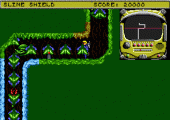
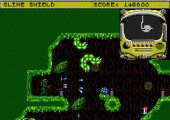
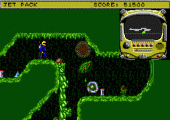
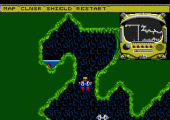
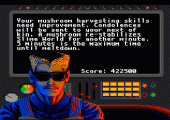
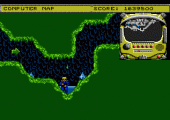
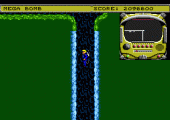
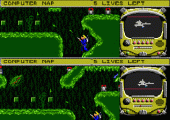
This game is ugly, plagued with slowdown, has hideous music and ear-shredding sound effects, and is full of cheap shots made all the worse by the finicky controls and repetitive, long-winded stage design.
Naturally, I couldn’t stop playing until I beat the whole thing.
How a game this damaged manages to be so addictive, I have no idea. 5/10, or 6/10 if you’re in a good mood; I can’t quite stretch to 7/10 with a presentation this bad.
I think the god awful controls and unconventional animation rendering just add to the charm. The numerous worlds are vast and dangerous, riddled with hidden pockets and shortcuts, making them a joy to explore. With co-op, open-world gameplay, the length never seemed long enough for me. Split-screen Metroid? Forever!
The 1v1 versus mode is insanely fun, dodging room-clearing bombs, other enemies, avoiding slime pellets in slow(-down) motion. Like a highly dramatic action movie. Dynamic music that adds layers of instruments with the intensity/proximity of your opponent is a brilliant UI innovation.
One of my top 5 favorite games on the Genesis. An enigma vis-a-vis its, yes, horribly atypical presentation and controls, the game is charming and fantastic! 9/10.